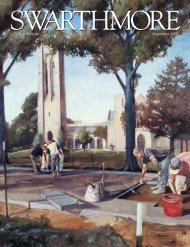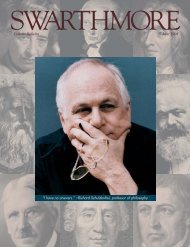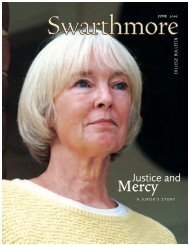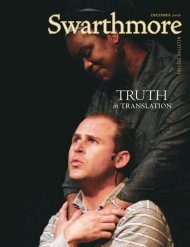Vietnam
Swarthmore College Bulletin (June 2006) - ITS
Swarthmore College Bulletin (June 2006) - ITS
- No tags were found...
Create successful ePaper yourself
Turn your PDF publications into a flip-book with our unique Google optimized e-Paper software.
the lowest-paid staff members.As far as living-wage campaigns go,Swarthmore saw much less student-administrationacrimony than the campaign Bartleyled at Harvard. “The Harvard board wascompletely secretive, with no schedule for itsmeetings, no public minutes,” Bartley said.“They had a complete disdain for what wewere trying to do.” Harvard President NeilRudenstine repeatedly refused to meet withcampaign leaders. Ultimately, Bartley andother students occupied Harvard’s administrationbuilding for 30 days, leaving onlywhen the university agreed to create a jointcommittee to recommend wage changes.“I was very sympathetic from the beginningto ensuring adequate compensation forour staff,” President Bloom said in a recentinterview. “We appointed a committee tostudy and recommend the level of wagesand benefits that would meet minumumneeds in our region. I was also mindful ofthe budgetary implications for the CollegePHOTOGRAPHS BY ELEFTHERIOS KOSTANSand the impact of a higher minimum wageon staff members who would not share inthat benefit.” Although the changes didn’tcome as soon as campaign organizers wouldhave liked, Bloom said it was important tofind a solution that the College could affordand that the broader community thoughtwas right.Blair maintains that the administration“over-intellectualized a problem that had apretty basic solution.” But despite the disagreements,the student-administrationrelationship during the campaign was “prettycordial,” Vice President for College andCommunity Relations and Executive Assistantto the President Maurice Eldridge ’61said.These days, “pretty cordial” is about asbad as student-administration relations getin terms of student activism. Responding toa student petition to sever Swarthmore’srelationship with Coca-Cola, citing allegedanti-union violence in Colombia, the Collegevoted its Coke shares in favor of ashareholder resolution, calling for an independentinvestigation into the allegations.And this year, it pulled the company’s bottledproducts from its snack bars. The Collegehas left open the question of whether itwill renew its Coca-Cola contract forSharples Dining Hall, when it ends in 2007.“We seek ways in which the College canresponsibly support student initiativesaimed at a better world—so that the institutioncan become their best ally,” said Bloom.Hanis of GI-Net said the College’s supportwas instrumental in the organization’s earlydays. “The President’s Office gave us somegrant money, got us a free phone line, andarranged for a basement office in the LangCenter for Civic and Social Responsibility.”Created in 2001 by an endowment establishedby Eugene Lang ’38, the Lang Centeris the latest tenant of the Swarthmore trainstation. From its perch between the campusand the larger community, it offers studentand community activists office and meetingspace as well as staff support for their work.Financial support also comes from LangOpportunity Scholarships of $10,000each. Recent recipients include Sa’ed Atshan’06, who founded the Palestinian StudentSociety of America. The group’s inauguralconference was held at Swarthmore thisspring.Another recipient, Bernadette Baird-Zars, started a language bank, enlisting 300student, staff, faculty, and alumni volunteersto provide translation services for asylumseekers and refugees. The organization covers38 languages. Its latest project, in conjunctionwith the Department of Justice, isrecording “Know Your Rights” presentationsto be made available at six detentioncenters around the country. “So, the immigrationdetainees will hear the voices ofSwarthmore students speaking Mandarinand Hindi and nine other languages,”Baird-Zars said.Today’s activists, to a degree much greaterthan their predecessors, say encouragementfrom faculty, staff, and administration havehelped them in their work. In contrast,1960s activists’ relationships with their liberalelders were strained.“Unlike the current generation ofactivists, we were building on very little—there wasn’t a foundation,” said Paul Booth,a former SDS leader who, today, is the executiveassistant to the president of the AmericanFederation of State, County, andMunicipal Employees. “We had some facultyencouragement but not much.”Now, many on Swarthmore’s faculty areBooth’s contemporaries, and current studentactivists cite professors as among theirbiggest supporters. Likewise, many administratorssaw the social conflagrations of the1960s up close from the students’ side.President Bloom, for example, was studyingin Paris in 1968, when student strikes led toa near revolution.Today’s activists have studied the successesand failures of the previous generation.“They’ve studied the successes of theearly civil rights movement and the bettermoments of the labor movement,” saidChristine Kelly, who teaches political scienceat William Paterson University. “They aren’treally caught up in that whole media imageof the 1960s and what it says about how anactivist should be.”Aaron Bartley agrees. “We grew up withan image of the 1960s,” he said. “It seemedlike a fairy tale.” No longer, though. And notin necrotic Buffalo, which Bartley is hopingto resuscitate—one house at time. It is noplace for fairy tales. TPaul Wachter has written for Legal Affairs,Salon.com, The Nation, and other magazines.june 2006 : 39

















